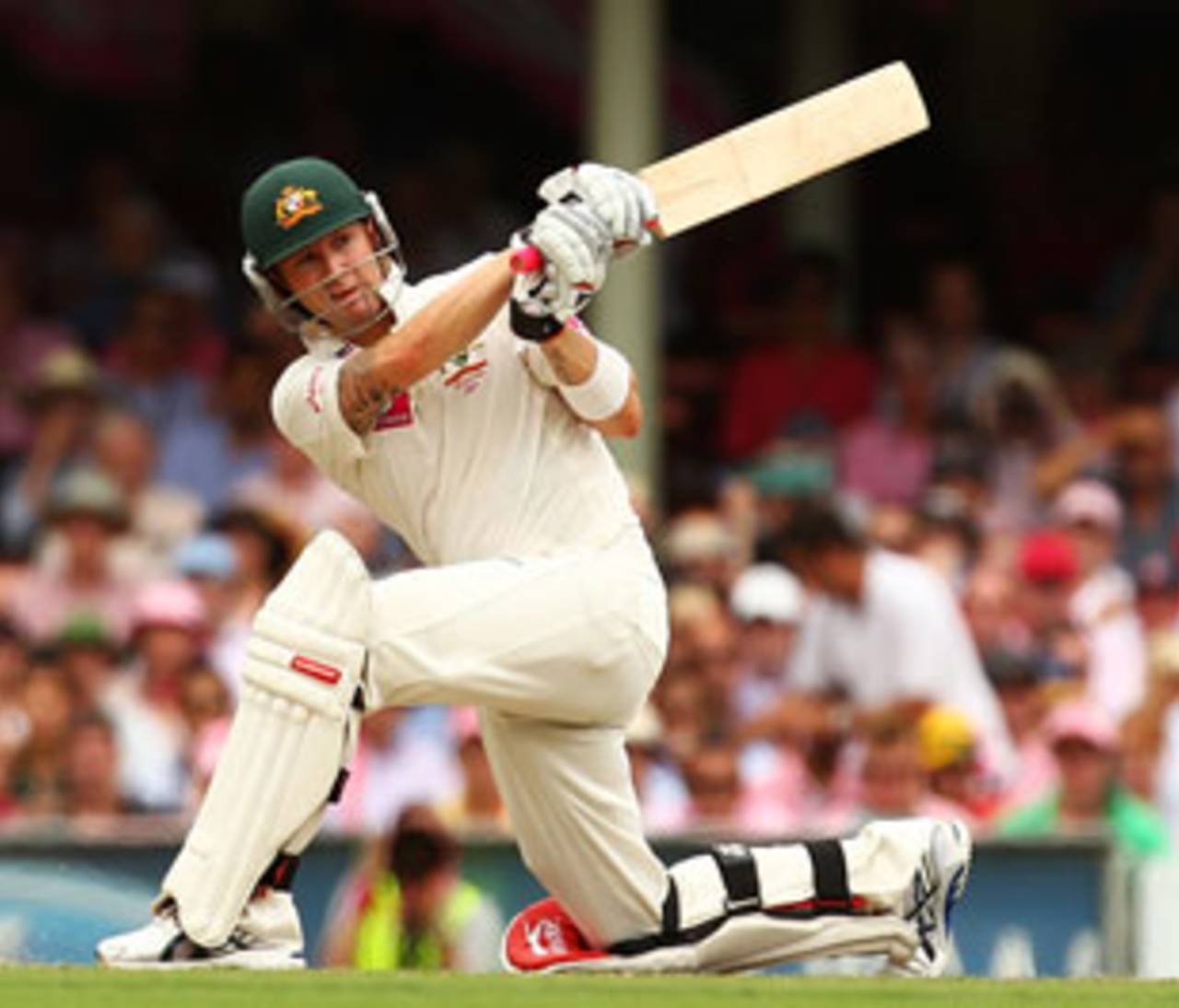Michael Clarke erects a monument
Michael Clarke battled fatigue to give Australia a tremendous lead and then put his team's interests first by choosing not to pursue Brian Lara's world record
Daniel Brettig at the SCG
05-Jan-2012

It was symbolic of the cricketer he has become that Michael Clarke reached his triple century with an unsponsored bat • Getty Images
In A Private Man*, Malcolm Knox's fictional web of cricket, family and porn, a down-on-his-luck Australian batsman walks out to the SCG seeking a "monument", the kind of innings no-one can question. Chris Brand carves a triple century, rough-hewn but admirable, and concludes it with a haughtily glib press conference.
Michael Clarke is cut from very different cloth to Brand, whose hard-bitten visage, harsh tongue and bawdy off-field pursuits are drawn from an earlier era of international cricket, but his undefeated 329 in Sydney was monumental by any measure. This was far more apparent on day three than day two, as Clarke dragged his clearly tired limbs through another three hours and 78 runs to move from 251 to the highest score ever made at the ground.
It was a display of resolve over fluency, mind over matter, and team over individual. Clarke's chief intention throughout was to place his side in the optimum position, first getting them out of trouble, then putting them in the lead, then streaking away from India to invite the possibility of an innings victory. As his score grew and grew, surpassing milestones this way and that, Clarke's eyes were less on the record books than the scorecard and the Members Pavilion clock - he wanted maximum time to try to bowl India out on a surface that has been anaesthetised since day one's early life.
Nevertheless, in chasing a team imperative Clarke also erected a resounding statement about himself and his batting. There have been other innings played in more difficult circumstances, most memorably in Cape Town last year, but also at Lord's in 2009 and even his debut century against India on a Bangalore turner in 2004. But the Sydney effort outdid them all, at least in terms of its vastness and consistent command of the bowling. With the exception of a return catch shelled by Ishant Sharma when Clarke was 182, at no stage did he look anything but completely in control of himself and his shots. R Ashwin will seldom face a more confounding opponent, whose fleet-footed approach to finger spinners has caused no less an authority than Graeme Swann to call Clarke his most difficult opponent.
Against the fast bowlers, Clarke's driving, both straight and through cover, was elegance unsurpassed, and he also showed plenty of power when tensing his arms to pull-drive several shortish deliveries through straight midwicket. His onside flicks carried the faintest whiff of Mark Waugh, not least that which scurried across the straight midwicket boundary to take Clarke past 300. Next ball Clarke swished fruitlessly at a ball wide of the stumps, but it was an error worth mentioning only for how much a surprise it was.
Every monument, of course, requires scaffolding to support its construction, and in Michael Hussey Clarke had the best of partners. If the stand of 288 with Ricky Ponting was heavier with significance, Clarke's unbeaten 334 with Hussey was the most unrelenting. Only three more bountiful fifth-wicket stands have existed in Test history. Given a few of his recent travails, Hussey had every right to feast on tired bowlers, and his free scoring allowed Clarke to conserve energy with quieter periods, including 20 overs without a boundary on the third morning. Between Clarke's marathon, and Ponting's drought-breaker, Hussey's 150 assumes similar dimensions to Adam Gilchrist's century alongside Steve Waugh on this ground in the 2003 Ashes - among the very best innings noticed by no-one.
No-one except Clarke, who had clearly considered Hussey's impending 150 more closely than the galaxy of batting records within his own reach. His closure arrived as Hussey raised his bat in acknowledgement, right on drinks at the midpoint of the match. Most at the ground were still discussing whether or not Clarke would make a play for Brian Lara's world record, 72 runs away, and virtually all had recognised the passing of the 334 shared by Don Bradman and Mark Taylor as a given. Instead they were startled out of their seats by the sight of Clarke and Hussey jogging off, intent on rounding up India's batsmen a second time.
As the crowd recovered from their initial shock, admiration became the more universal sentiment. Clarke's performance was entirely worthy of the occasion, and he honoured it further by placing his team first. There were those in the past all too ready to criticise Clarke as a self-absorbed individual, mollycoddled by management and sponsors before his 20th birthday and living in a bubble ever since. Those detractors had been put in their place already by the end of the second day, and they shrank still further from view on the third.
It was not insignificant that Clarke made his runs with a clean-skin bat after Slazenger, the company that signed him up on a six-figure sum as a teenager, chose not to renew their deal with him for 2012. Having turned away from the Twenty20 dollar, Clarke has become far more of an establishment figure than had ever seemed possible when he began. Sydney has shown him to be much the better batsman for it, worthy of a place above the likes of Lara, RE Foster and Doug Walters as scorer of the highest innings at the grand old ground. His captaincy is gathering strength with each series, and by constructing a monument at the SCG, Clarke has the job for as long as he may want it. Even a character as gnarled as Chris Brand would have to be impressed by that.
*Also known as Adult Book.
Daniel Brettig is an assistant editor at ESPNcricinfo